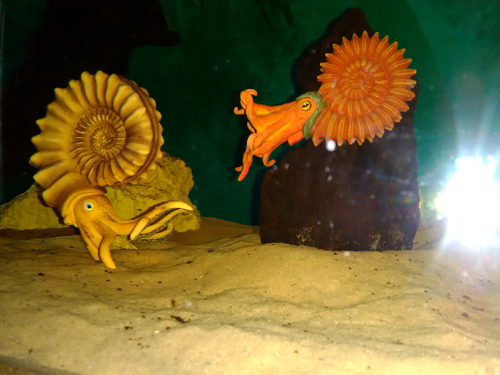Ammonites on Display
When working with Key Stage 1 classes we like to give the young children the opportunity to handle and explore fossils. Fortunately, we have lots of fossils to show them, including a lot of different sized ammonites.
We ask the children to think of words that mean the same as “small” when it comes to describing the ammonites and we delight in being told that we have “tiny”, hand-sized”, “baby” ammonite fossils. Then we ask the class to think of words that mean the same as “big” to help us describe the larger ammonite fossils that we bring into the classroom. We have lots of amazing words, “giant”, “gigantic”, “huge” and even “enormous”. This is a great exercise that not only explores the properties of materials (the fossils), but allows the children the opportunity to develop their vocabulary too.
An Ammonite Aquarium
Picture credit: Paleo Paul
For models and replicas of ammonites and other prehistoric creatures: Models of Iconic Fossils such as Ammonites.
Ammonites
Ammonites were all marine creatures, (they all lived in saltwater). The picture above shows a photograph of ammonite models in a pretend aquarium. This is a great way to show what the animals whose fossil shells the children have been handling actually looked like. An ammonite aquarium, can make a useful addition to the Key Stage 1 scheme of work especially when it comes to considering what animals need to live and what animals live where.
Extension Topic Ideas
Lots of challenging questions can come out of an exploration of ammonite fossil shells:
- What other animals live in the sea? Can the children make a seascape?
- Why do the shells fossilise? Why doesn’t the rest of the ammonite become a fossil too?
- What food did ammonites eat?
- Ammonites live in the sea and they have tentacles, what other animals live in the sea today which also have tentacles?
To purchase ammonite models, plus real fossils to use in school, visit Everything Dinosaur’s website: Visit Everything Dinosaur’s Website


